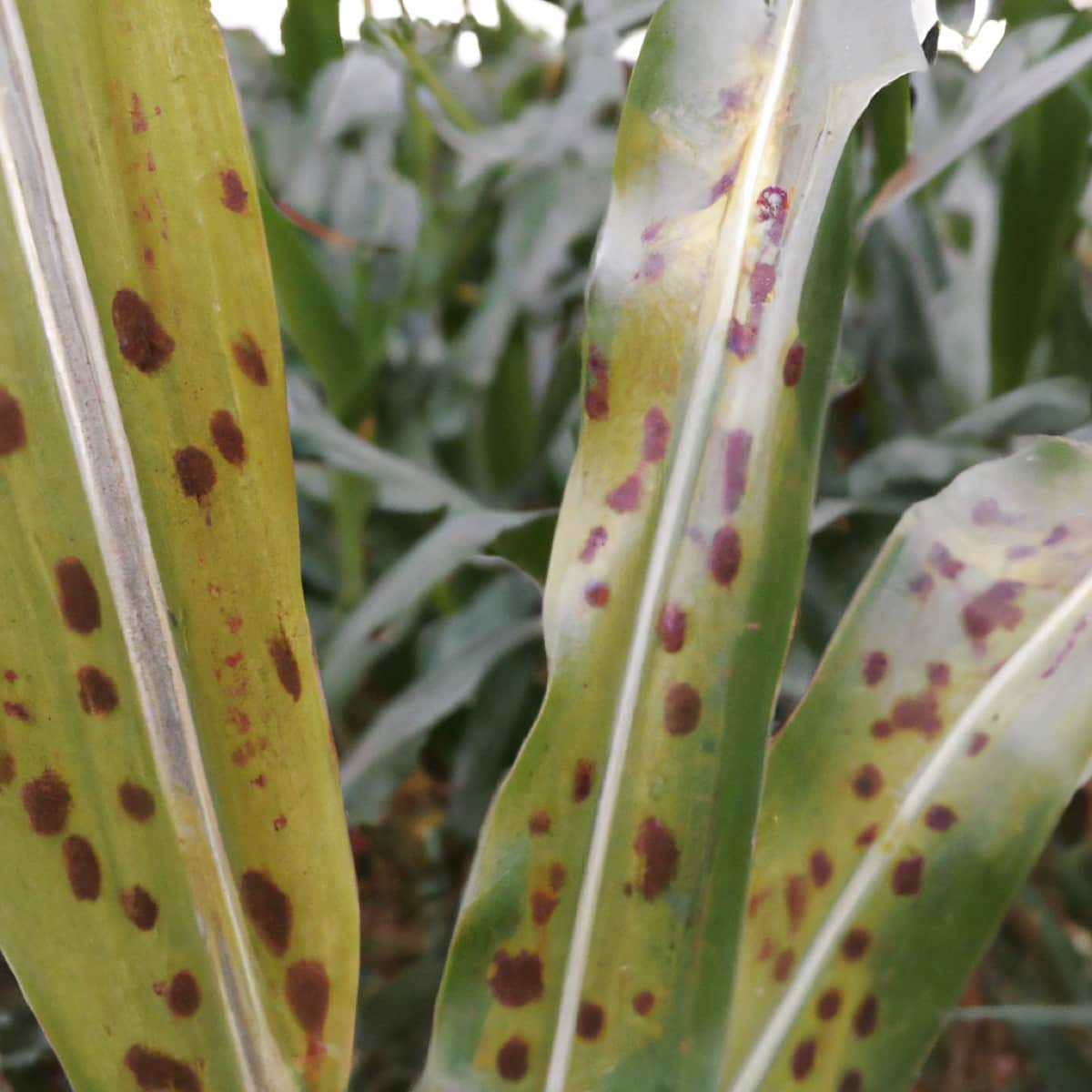The Maize Leaf Blight Disease is a destructive fungal disease of maize crops caused by the Ascomycota pathogens and is also known as northern corn leaf blight or southern corn leaf blight. The fungus can affect plant parts, such as the stalk, ears, and grains. It is important to understand the parameters that contribute to disease development.

Maize leaf blight can be managed through resistant varieties, fungicide applications, and crop rotation. To effectively manage this disease, it is important to understand its disease cycle, the mode of disease spread, and the best methods for controlling it. This article will provide an overview and discussion of the Maize Leaf Blight Disease in Maize crops, including its symptoms, identification techniques, and control.
Maize Leaf Blight Disease Management in Maize
The Causal Organism of Maize Leaf Blight Disease
- Exserohilum turcicum (Helmithosporium turcicum) and Bipolaris maydis (Cochliobolus heterostrophus or Drechslera maydis or Helminthosporium maydis) are the commonly distributed leaf blight pathogens. They belong to the Family Pleosporaceae, Order Pleosporales of the Phylum Ascomycota.
- The pathogen Exserohilum turcicum causes Northern Corn Leaf Blight Disease, whereas Bipolaris maydis causes Southern Corn Leaf Blight Disease in maize.
- They are unique diseases caused by separate funguses with common symptoms of elongated grayish-green to tan lesions on the leaves of maize crops.
The Disease Cycle of Maize Leaf Blight Disease
The disease cycle begins when the conidia of the pathogen primarily spread from soil and dormant mycelium in infected seeds. And the secondary spread occurs by many different mechanisms when the conidiophores are spread by wind, splashing rain, and contact with infected plants.
The respective fungal pathogens produce geniculate conidia on the conidiophores in which every conidium has 7-11 septa. The conidia infect the hosts via wind and begin to infect the host by bipolar germination in free water on the leaves. The symptoms begin to show within 1-2 weeks of infection. The teleomorph or perfect stage of H. turcicum is Trichometasphaeria turcica, and of H. maydis is Cochliobolus heterostrophus Drechsler, during which they form the fruiting body perithecia comprising of Asci and ascospores inside.
Occurrence of Maize Leaf Blight Disease in Maize Crop
- Location of Maize Leaf Blight disease: This disease is observed in countries like the USA, the UK, Mexico, Argentina, Brazil, Germany, Colombia, Peru, Ecuador, Africa, Afghanistan, Bangladesh, China, India, Indonesia, New Zealand, Korea, Sri Lanka, Thailand, and Australia.
- Host range: The crops susceptible to leaf blight are wheat, rye, barley, oats, sorghum, seeds of green gram, black gram, cowpea, varagu, Sudan grass, Johnson grass, and Teosinte. The disease can be spread to other vegetable crops like tomatoes, potatoes, peppers, eggplants, and cruciferous vegetables such as cabbage and broccoli.
Favorable Conditions for Maize Leaf Blight Disease Spread in the Field
- Humid, rainy, windy, and warm weather is favorable for the growth and spread of the disease in the cornfield.
- The fungus thrives in Temperatures between 18-27°C and more than 80% Relative Humidity.
- High Moisture Levels and Dense Planting of maize plants allow the spread of the disease through contact between the infected plants.
- Poor Crop Rotation and Inadequate Crop Management can also contribute to the spread of the disease.
Symptoms of Maize Leaf Blight Disease
- The symptoms of maize leaf blight disease include yellowing and wilting of the leaves and the formation of oval and cigar-shaped lesions.
- The fungus can also cause blighting of the plant’s stalk and ear, leading to lodging and reduced yields.
- Maize leaf blight is characterized by large, irregularly-shaped tan-gray lesions on the upper and lower leaf surfaces, eventually leading to leaf death and defoliation.
- In severe infestation, the lesions will coalesce to give a blighted appearance. These lesions are encircled in a reddish-brown margin.
- The conidia and conidiophores accumulate on the upper leaf surface as a huge mass in the center.
- Leaf blight can also spread to the twigs and branches, resulting in cankers and dieback.
In case you missed it: Maize/Corn Downy Mildew Disease Management: Symptoms, Treatment, Chemical, Biological, Natural, and Organic Control

Percentage of Yield Loss due to Maize Leaf Blight Disease in Maize Crop
- In the United States, maize leaf blight disease causes up to 50% yield loss, depending on the outbreak’s severity. In Africa, yield losses range from 20-60%. In India, the disease causes up to 80% yield loss. The yield loss is typically lower in the United Kingdom than in other countries, ranging from 5-20%.
- In Canada, losses can range from 5-50%. In Australia, yield losses range from 10-60%; in New Zealand, losses can range from 5-30%. The ETL for maize leaf blight disease is set at an average of 5% of the leaf surface area affected by the disease.
Cultural Control measures of Maize Leaf Blight Disease
- Sanitation: It involves disposing of infected plants, removing crop residues from the field, and cleaning equipment after harvest to reduce the number of spores and fungi available to cause infection.
- Mulching: Mulching around the plants can help reduce soil moisture and improve air circulation, which can reduce the chances of infection.
- Resistant varieties: The resistant hybrid Ganga white-2 and composite variety Vijay are resistant to Maydis Leaf Blight. And growing other resistant varieties of maize like Deccan, VL 42, Prabhat, KH-5901, PRO-324, PRO-339, ICI-701, F- 7013, F-7012, PEMH 1, PEMH 2, PEMH 3, Paras, Sartaj, Deccan 109, COH-6 can help reduce the impact of leaf blight.
- Roguing out: Removing and burning the infected plants is necessary to prevent the spread of this disease throughout the field.
Biological Control measures of Maize Leaf Blight Disease
- Fungal antagonists: Trichoderma spp. produces chitinases and glucanases that can degrade the cell walls of fungal pathogens and also produce antibiotics such as harzianum and antifungal proteins that can further inhibit the growth of the pathogen.
- Bacterial antagonists: Pseudomonas fluorescens can produce antibiotics such as pyoluteorin and phenazines, as well as antifungal proteins and chitinases that inhibit the growth of the pathogen.
- Viral antagonists: Maize streak virus can effectively control leaf blight by preventing them from germinating and stimulating beneficial bacteria growth.
Chemical Control measures of Maize Leaf Blight Disease
- Soil application – Mix 2.5kg of P. fluorescens (or) T. viride with 50 kg of well-decomposed FYM or sand ten days before application and distribute the mixture uniformly 30 days after sowing.
- Seed treatment – Treat the seeds with Captan or Thiram at 4 grams/kg for maydis leaf blight. And with 25 grams of Azospirillum and 6 grams of Trichoderma per kg of seeds or 2 grams of Thiram 75 WP, or 2 grams of Captan 50 WP per kg of seeds before sowing for turcicum leaf blight.
- Spray application – Apply 2kg Mancozeb per ha or 1kg Captan per ha or 1kg Metalaxyl per Liter or 2-2.5 grams Mancozeb per Liter after 15-35 days from sowing and two more sprays at a 10-day interval in one hectare after the disease appeared for the first time or Azoxystrobin 18.2% + Difenconazole 11.5% w/w SC 1ml/Liter of water immediately after symptoms appearance for maydis leaf blight.And spray 2.5g Mancozeb 75WP or 1ml Hexaconazole 5EC or 1ml combi-product fungicide, Azoxystrobin 18.2% + Difenconazole 11.4% per Liter of water immediately after the appearance of the disease symptoms for turcicum leaf blight.
Preventive Measures for Control of Maize Leaf Blight Disease
- Crop monitoring – Regularly monitoring fields for signs of disease will help to catch and manage it early before it spreads.
- Planting disease-free seeds – Planting disease-free seed is essential in preventing the spread of Maize Leaf Blight Disease. Farmers should purchase seeds from reliable sources and avoid planting maize that shows signs of disease.
- Avoid overcrowding – Plants should not be overcrowded when planted to reduce the chances of disease. This will reduce the chances of the disease spreading from one plant to another.
- Pruning – Pruning can help to reduce the spread of the disease. Pruning off infected leaves and stems can help reduce the number of fungal spores on the plants.
In case you missed it: Maize Rust Disease Management: Symptoms, Treatment, Chemical, Biological, Natural, and Organic Control

Conclusion
The maize leaf blight disease is a major threat to maize crops and can cause serious losses in yield. However, with proper preventive measures, such as crop rotation, early detection, and appropriate management of the disease, farmers can reduce the impact of this disease on their crops and maximize yields. By understanding the biology of the disease and taking the necessary steps to prevent it, farmers can ensure that their maize crops remain healthy and productive.
- Deworming Schedule for Dogs/Puppies: A Beginners Guide
- How to Prevent and Control Parasites in Goats
- Beneficial Insects in Pest Management
- Natural Solutions for Pest Control in Flower Gardens
- Types of Fungicides Used in Agriculture
- Common Issues in the Fruit Development Stage of Pomegranate Farming
- Fruit Development Issues in Papaya: Easy Solutions and Treatment
- Soil-Borne Diseases and How to Protect Your Plants
- Practices to Prevent Disease Spread in the Garden